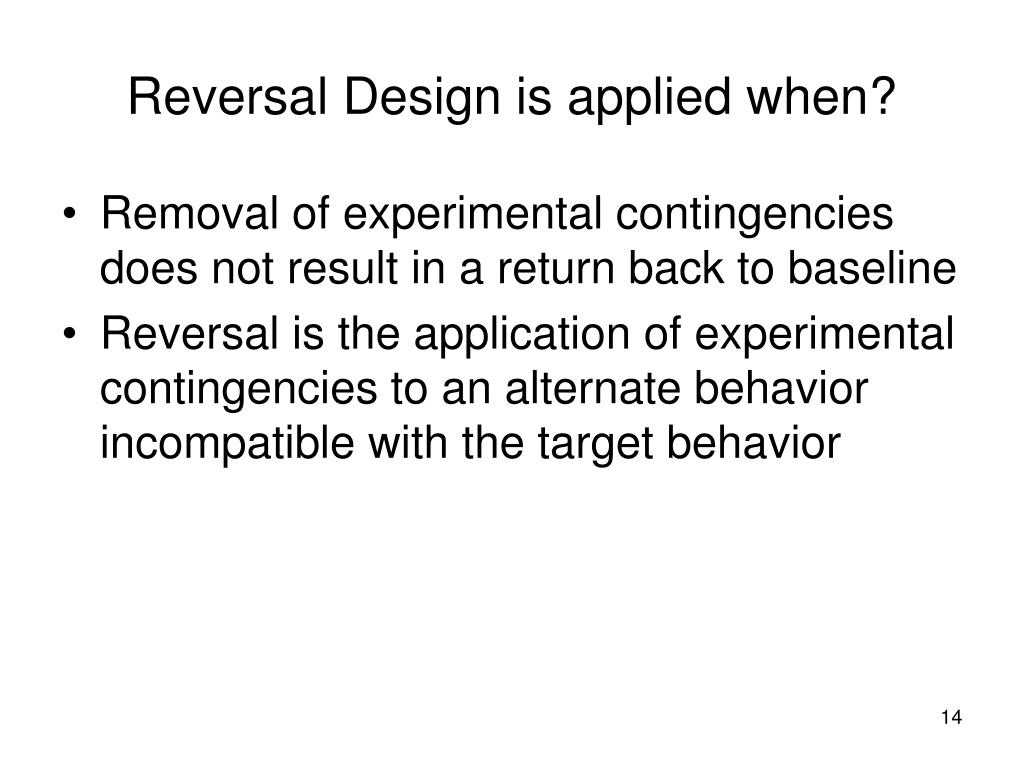Table Of Content

One solution to these problems is to use a multiple-baseline design, which is represented in Figure 10.4. The key to this design is that the treatment is introduced at a different time for each participant. Single-subject research, by contrast, relies heavily on a very different approach called visual inspection. But if the dependent variable changes when the treatment is introduced for multiple participants—especially when the treatment is introduced at different times for the different participants—then it is unlikely to be a coincidence. Group data are described using statistics such as means, standard deviations, Pearson’s r, and so on to detect general patterns. The multiple baselines can be for different participants, dependent variables, or settings.
Now Offering $500 OFF Vasectomy Reversal*
A study method in which the researcher gathers data on a baseline state, introduces the treatment and continues observation until a steady state is reached, and finally removes the treatment and observes the participant until they return to a steady state. While this A-B-A experimental design is well-known, there are many variations (e.g., A-B-A-B or B-A-B) that allow for replication of the baseline and intervention. The A-B-A-B design, such as the graph above, allows for better experimental control and, therefore, is favored.

Reversal Designs
Since SCEDs rely on repeated measures and a detailed study of the relationship between treatment and outcome, studies that use dependent measures that cannot be sampled frequently are not candidates for SCEDs. Likewise, the failure to identify a temporal relationship between the introduction of treatment and initiation of change in the outcome can make attribution of changes to the intervention challenging. A confounding variable’s association with introduction or removal of the intervention, which may cause inappropriate decisions about the effects of the intervention, is always possible. Dropout or uncontrolled events that occur to individuals can introduce confounding variables to the SCED.
Integrating Single-Case Experimental Designs Into Randomized Controlled Trials
It can be especially telling when a trend changes directions—for example, when an unwanted behaviour is increasing during baseline but then begins to decrease with the introduction of the treatment. While reversal designs can be used to compare effects of interventions, multiple baseline designs provide experimental control for testing one intervention but do not compare different interventions. These comparisons can be made for several different interventions with the combination of both designs to demonstrate experimental control and compare effects of the interventions. They were interested in how a school-wide bullying prevention program affected the bullying behaviour of particular problem students.

D-5: Use single-subject experimental designs (e.g., Reversal, Multiple Baseline, Multielement, Changing Criterion) ©
In the bottom panel of Figure 10.6, however, the changes in level are fairly small. And although there appears to be an increasing trend in the treatment condition, it looks as though it might be a continuation of a trend that had already begun during baseline. This pattern of results strongly suggests that the treatment was not responsible for any changes in the dependent variable—at least not to the extent that single-subject researchers typically hope to see. Another important aspect of single-subject research is that the change from one condition to the next does not usually occur after a fixed amount of time or number of observations. Specifically, the researcher waits until the participant’s behavior in one condition becomes fairly consistent from observation to observation before changing conditions. The idea is that when the dependent variable has reached a steady state, then any change across conditions will be relatively easy to detect.
Integrating Multiple Baseline and Reversal Designs
Our hope is that this article will inspire a diverse array of students, engineers, scientists, and practitioners to further explore the utility, rigor, and flexibility of these designs. As an example, consider a study by Scott Ross and Robert Horner (Ross & Horner, 2009)[2]. They found that the number of aggressive behaviors exhibited by each student dropped shortly after the program was implemented at the student’s school. One of them is changes in the level of the dependent variable from condition to condition. A second factor is trend, which refers to gradual increases or decreases in the dependent variable across observations. A third factor is latency, which is the time it takes for the dependent variable to begin changing after a change in conditions.
Single-subject research
Ideal for sloped lots, reverse living house plans are a great choice for building lots with panoramic views. With a reverse living floor plan often the bedrooms, garage, storage, and other secondary spaces are on the ground or main floor. The social gathering spaces such as the living room, dining room, kitchen, and when space allows the master bedroom are on the upper level.
Dr. Werthman discusses vasectomy reversal and the second chances it gives couples who want to build a biological family after vasectomy. In this design two or more treatments are alternated relatively quickly on a regular schedule. Alzheimer’s affects approximately 5.4 million Americans and 30 million people globally.
Pension reversal puts focus on financial literacy - Deccan Herald
Pension reversal puts focus on financial literacy.
Posted: Wed, 27 Sep 2023 07:00:00 GMT [source]
The greater the percentage of non-overlapping data, the stronger the treatment effect. The most basic single-subject research design is the reversal design, also called the ABA design. The mean and standard deviation of each participant’s responses under each condition are computed and compared, and inferential statistical tests such as the t test or analysis of variance are applied (Fisch, 2001)[3]. (Note that averaging across participants is less common.) Another approach is to compute the percentage of non-overlapping data (PND) for each participant (Scruggs & Mastropieri, 2001)[4].
Recall that we encountered this same principle when discussing experimental research more generally. The effect of an independent variable is easier to detect when the “noise” in the data is minimized. SCEDs can identify the optimal treatment for an individual person rather than the average person in a group (Dallery & Raiff, 2014; Davidson et al., 2021; Hekler et al., 2020). That is, a person’s outcomes in one phase are compared to outcomes in another phase. In a typical study, replications are achieved within and/or across several individuals; this allows for strong inferences about causation between behavior and the treatment (or levels thereof).
In a multiple-treatment reversal designA single-subject research design in which phases that introduce different treatments are alternated., a baseline phase is followed by separate phases in which different treatments are introduced. The participant could then be returned to a baseline phase before reintroducing each treatment—perhaps in the reverse order as a way of controlling for carryover effects. This particular multiple-treatment reversal design could also be referred to as an ABCACB design. Other less commonly used designs within the family of SCEDs may be useful for personalized medicine. While the treatment period may be short, many more replications of treatments—and ineffective treatments—can be identified quickly.
In this design, multiple baselines are either established for one participant or one baseline is established for many participants. The percentage of responses in the treatment condition that are more extreme than the most extreme response in a relevant control condition. A baseline phase is followed by separate phases in which different treatments are introduced. The dependent variable ranges between 12 and 16 units during the baseline, but drops down to 10 units with treatment and mostly decreases until the end of the study, ranging between 4 and 10 units. Just like with many home designs, the inverted floor plan isn't everyone's cup of tea. From a practical perspective, the idea of having to lug groceries up another flight of steps might not be palatable without the help of the aforementioned elevator.
Her children noticed she commonly lost her train of thought in mid-sentence, and often asked them if they had carried out the tasks that she mistakenly thought she had asked them to do. She was considering quitting her job, which involved analyzing data and writing reports, she got disoriented driving, and she mixed up the names of her pets. Visual inspection of the data suggests an effective treatment in the top panel but an ineffective treatment in the bottom panel.

No comments:
Post a Comment